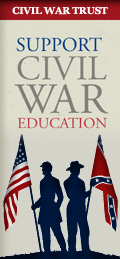Uncovering the stories behind the faces of the Confederacy
By C.D. Myers
McClatchy-Tribune News Service
June 17, 2009
Capt. Jesse Cunningham McNeill felt slighted by the lack of confidence his top commander had in his leadership ability.
When the chance came to lead an audacious Confederate Rangers operation during the American Civil War, though, the petulant McNeill seized the moment, and ultimately pulled off one of the most daring actions of the conflict: the kidnapping of high-ranking Union officers at their lodgings in Cumberland, Md., in February 1865.
While publications abound about the lives of famous Confederate leaders such as Robert E. Lee and Thomas "Stonewall" Jackson, stories about the Confederate rank and file, like McNeill, have gone largely untold.
Ronald S. Coddington helps expand this area of Civil War knowledge in "Faces of the Confederacy; An Album of Southern Soldiers and Their Stories" (Johns Hopkins University Press). This exceptional companion edition to Coddington's 2004 book, "Faces of the Civil War: An Album of Union Soldiers and Their Stories," reconstructs the lives of 77 Confederate soldiers below the rank of colonel, through engaging narratives complemented by rare carte-de-visite (CDV) portrait photographs.
Several soldiers featured in "Faces of the Confederacy; An Album of Southern Soldiers and Their Stories" participated in some of the war's most famous battles. But the book also serves up insights into many other facets of the Civil War experience beyond the major engagements. A half dozen of the soldiers included here, for example, found themselves part of "The Immortal 600," a group of prisoners held by the Union, and used as human shields in a deadly standoff with Southern forces at Charleston, S.C.
The activities of rebel rangers - partisan units that conducted guerilla raids against northern communities and Union troops during the war - similarly come to light through stories about Confederates that served with, among others, John Mosby, William "Bloody Bill" Anderson and John Hunt Morgan.
Additionally, some remarkable family connections emerge in Coddington's text, as with William McNeill Whistler, a Confederate assistant surgeon and brother of American artist James Abbott McNeill Whistler. After the war, he joined his famous sibling as an expatriate in Europe.
Unlike the service files of Union soldiers maintained by the National Archives, information about Confederate enlisted soldiers is less readily available. Faced with this dilemma, Coddington became a top-level history detective. Using the CDV photographs as a starting point, the author tracked down his Confederate profiles through a wide range of resources, including personal correspondences, remembrances and newspaper accounts.
Pinpointing when and where the Confederates CDV images in the book were taken likewise offered a challenge. Yet, Coddington managed to find the approximate date and location of select images. Surprisingly, he discovered that a number of the individuals sat for their portraits not in a Southern photo studio, but during their time as detainees in Union prisons.
The attitudes conveyed in the CDVs span the expression spectrum. Many of the pictured Confederates assumed a restrained manner, and appear in poses common for the day. Other figures present a more informal, demonstrative air, as with the boyish-looking Jesse McNeill, who strikes a brash, if not irascible, demeanor.
For the Confederates in the book who survived, Coddington uncovered a record of mixed fates in the postwar years. A significant number of Confederate veterans returned to their home states after the conflict, and became successful in a range of pursuits. A few, however, elected to resettle in Northern states, including the former ranger McNeill. The one-time Missouri native moved to Illinois in the 1870s, fathered a large family, and lived to age 70.
|
